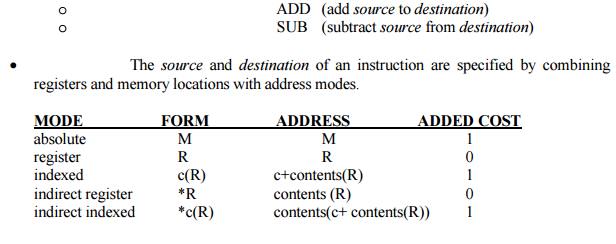Chapter: Principles of Compiler Design : Code Generation
Target Machine
TARGET MACHINE
Familiarity with the target machine and its instruction set is a prerequisite for
designing a good code generator.
The target computer is a byte-addressable machine with 4 bytes to a word.
It has ngeneral-purpose registers, R0, R1, . . . ,
Rn-1.
It has two-address instructions of the form:
o
op source, destination
o
where, opis an op-code, and sourceanddestinationaredatafields.
·
It has the following op-codes :
o
MOV (move sourcetodstination)

For
example : MOV R0, M stores contents of Register R0 into
memory location M.
Instruction costs :
• Instruction
cost = 1+cost for source and destination address modes. This cost corresponds
to the length of the instruction.
• Address
modes involving registers have cost zero.
• Address
modes involving memory location or literal have cost one.
• Instruction
length should be minimized if space is important. Doing so also minimizes the
time taken to fetch and perform the instruction.
For example : MOV R0,
R1 copies the contents of register R0 into R1. It has cost one, since
occupies only one word of memory.
• The three-address
statement a : = b + c can be implemented by many different instruction
sequences :
i)
MOV b, R0
ADD c, R0 cost = 6 MOV R0, a
ii)
MOV b, a
ADD
c, a cost = 6
iii) Assuming R0, R1 and R2 contain the addresses of
a, b, and c : MOV *R1, *R0
ADD
*R2, *R0 cost = 2
• In order to generate
good code for target machine, we must utilize its addressing capabilities
efficiently.
Related Topics